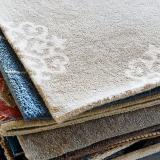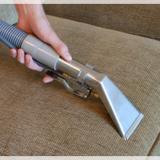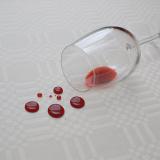Our Blog
Please feel free to post a question or just join the conversation.
All About Fabric Protection

Well, lets explore the science behind fabric protection.
The fabric protection treatment that is most widely used by professionals and has a dominant position in the cleaning industry is Fluorochemical. They are the choice of professionals because they repel both water and oil-based stains and spills. Fabric protectors lower the surface energy of the fiber, making it difficult for both spills and soil to penetrate the fibers. Since they dont penetrate the fiber, the spill will not have any impact on either the dyes in the fibers or the fiber itself.
Fabric protection treatments come in two ways, water-based or solvent-based. Water-based protectors are designed to be used on carpets and rugs. This is because any solvent-based product could penetrate the backing of a rug and hurt any latex backing. So this will allow you to apply to the entire fiber without the worry of any damage done to the backing of the rug.
Solvent-based protectors are preferred to be used on upholstery for several reasons. Due to the use of a solvent as a carrying agent, it allows maximum and uniform coverage and penetration without having any fears of shrinkage, color bleeding and will not change the looks or feel of anything it is applied to. The solvent that is used in almost every product regardless of who the manufacturer is, is an odorless mineral spirit due to the safety of its use within a home environment and the safety of anyone using it. Other solvents were used in past years but stricter government regulations have removed these other solvents used.
Now the science. The absorption rate of fiber or liquid into a fiber can be measured by either a newton or a dyne rating. A dyne is a unit of force measurement with a relationship also to time. This is similar to an inch is a unit of measurement in distance or a pound is a unit of weight. A dyne scale is most commonly used by scientists and physics. In laymans terms, it is simply a measurement of potential surface energy or wetting ability.
To understand how this plays a role in fabric protection treatments. Consider water having a dyne rating of px. 73 dynes, ammonia is approximate 24 dynes. Now, most cleaning detergents have a dyne rating between 25 and 55 dynes. These detergents when added to water give it a lower dyne rating and make water wetter so it penetrates a surface quicker. This penetration allows cleaners to absorb into a fabric to break down and remove soil and stains. Firefighters will often use a detergent added to water when fighting a forest fire so the water will penetrate the ground where a fire may be hiding, waiting to rear up later.
Now, the lower the dyne rating the better. Just remember the lower dyne rating wins. So if a particular fiber or fabric may have a dyne rating of say 80 and you spill a drink on it, like grape juice which may have a dyne rating of say 30. Unfortunately, it will absorb into the fabric since it has a lower dyne rating. Now, take that same fabric and apply a good quality fabric protection treatment and you lower the dyne rating to say 20. Once treated, that same juice spill will bead on top of the fabric since the treated fiber has a much lower dye rating of 20. This prevents the absorption, thus prevents any possible staining.
Just having a lower dyne rating is not the whole story though. There are other factors at work. Yes, you can lower the surface energy of any fabric treated but remember other factors can come into play. They are heat and acids. When a liquid is heated, like hot tea or hot coffee, it lowers the dyne rating of that liquid dramatically and can absorb into even a well-treated fabric. Also, corrosive acids can essentially eat through a good protective treatment if left alone. So, the bottom line, apply a good quality fabric protector but remember to address any stain as soon as possible. The quicker you react the less likely anything will penetrate through the protection applied.
There are many different fabric treatments which although may be similar to each other, I find that the specific blends of complex fluorochemical show superior results to others. With over 50 years of experience in the carpet and upholstery cleaning business and is certified in the application of fabric protection treatment in the 70s has allowed me to see first-hand any changes in our industry and the products available. At Alecs Carpet & Upholstery Cleaning LLC, we are an independent company and not tied to the use of just one product from one supplier. Instead, we can examine and test any new product and new technology that has entered the market. We are constantly testing any new products that come out so we are ensured to be using the best possible product it is available.
If you have any questions about fabric treatments or anything else, please feel free to contact me at my office at 781-871-4428 or send me an e-mail at Alec@Alecscarpetandupholsterycleaning.com
Read more about fabric protection on our website at http://alecscarpetcleaning.com/fabric-protection-for-your-finest-upholstered-furniture.
note_stackRelated Posts
Author's recent posts
- Towns That We provide Service To Feb 20
- Wearing Shoes in Your Home Aug 1
- Restoring Protected Leather May 28
Blog Categories
-
 Carpet Cleaning (13)
Carpet Cleaning (13)
-
 Spot Cleaning (13)
Spot Cleaning (13)
-
 About Rugs (5)
About Rugs (5)
-
 Upholstery Cleaning (3)
Upholstery Cleaning (3)
-
 About Carpets (2)
About Carpets (2)
-
 Fabric Protection (2)
Fabric Protection (2)
-
 Leather Upholstery (2)
Leather Upholstery (2)
-
 Stains on Carpets (1)
Stains on Carpets (1)
-
 Discussions on Carpet & Upholstery (1)
Discussions on Carpet & Upholstery (1)
-
 Fabrics (1)
Fabrics (1)
-
 News (1)
News (1)
